Sir John Monash, Personal Files Book 16, 3 September - 9 October 1917, Part 20
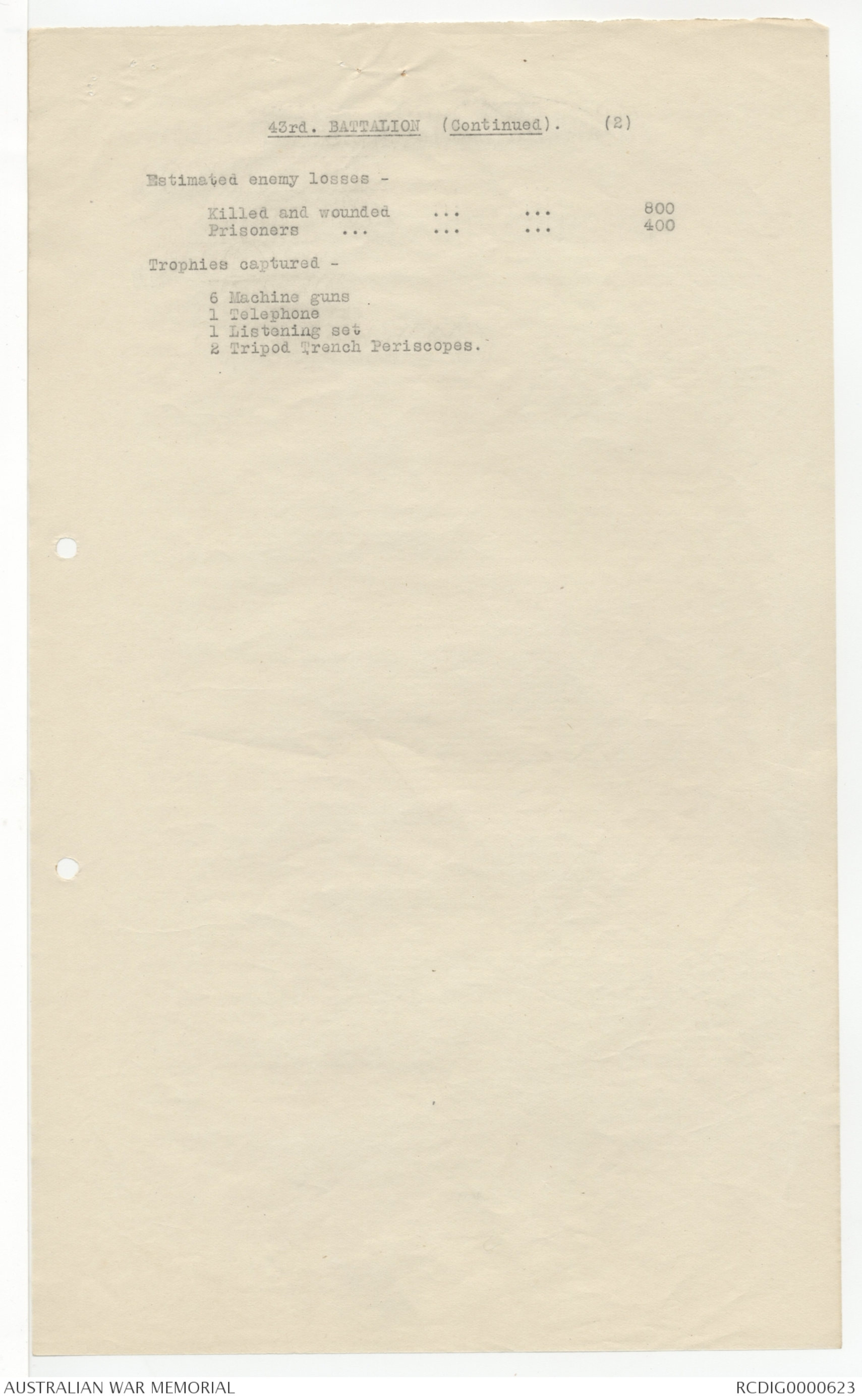
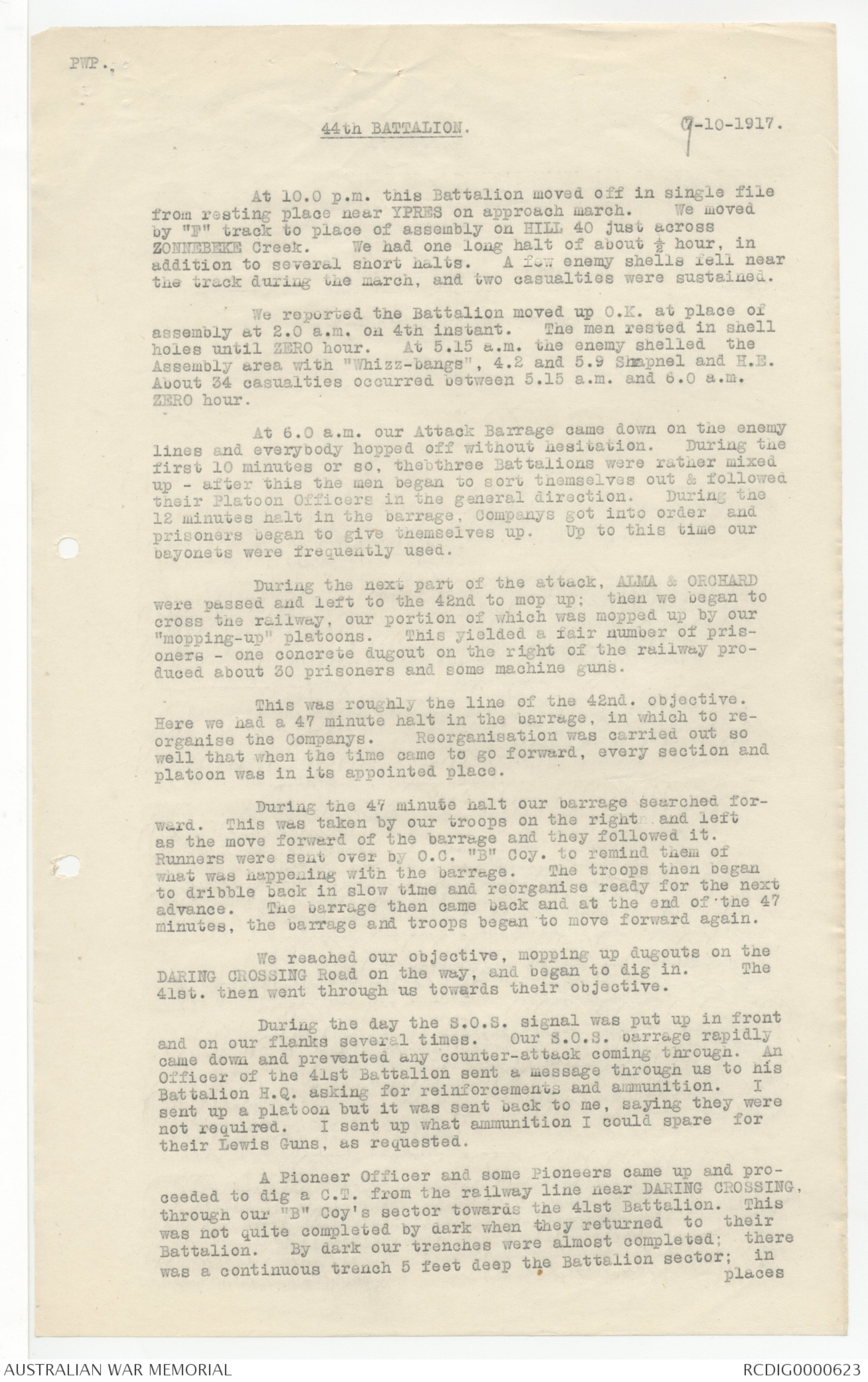
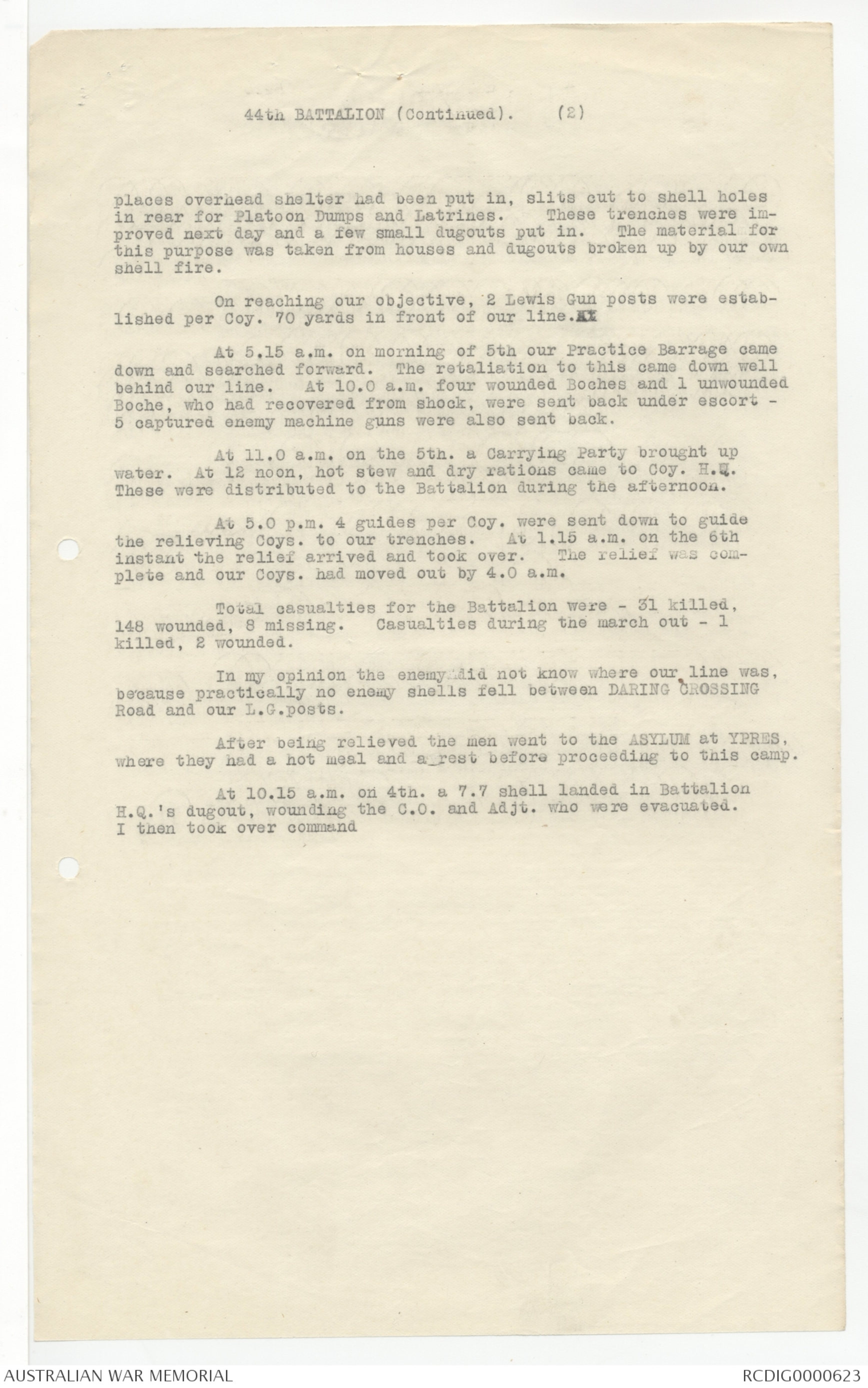
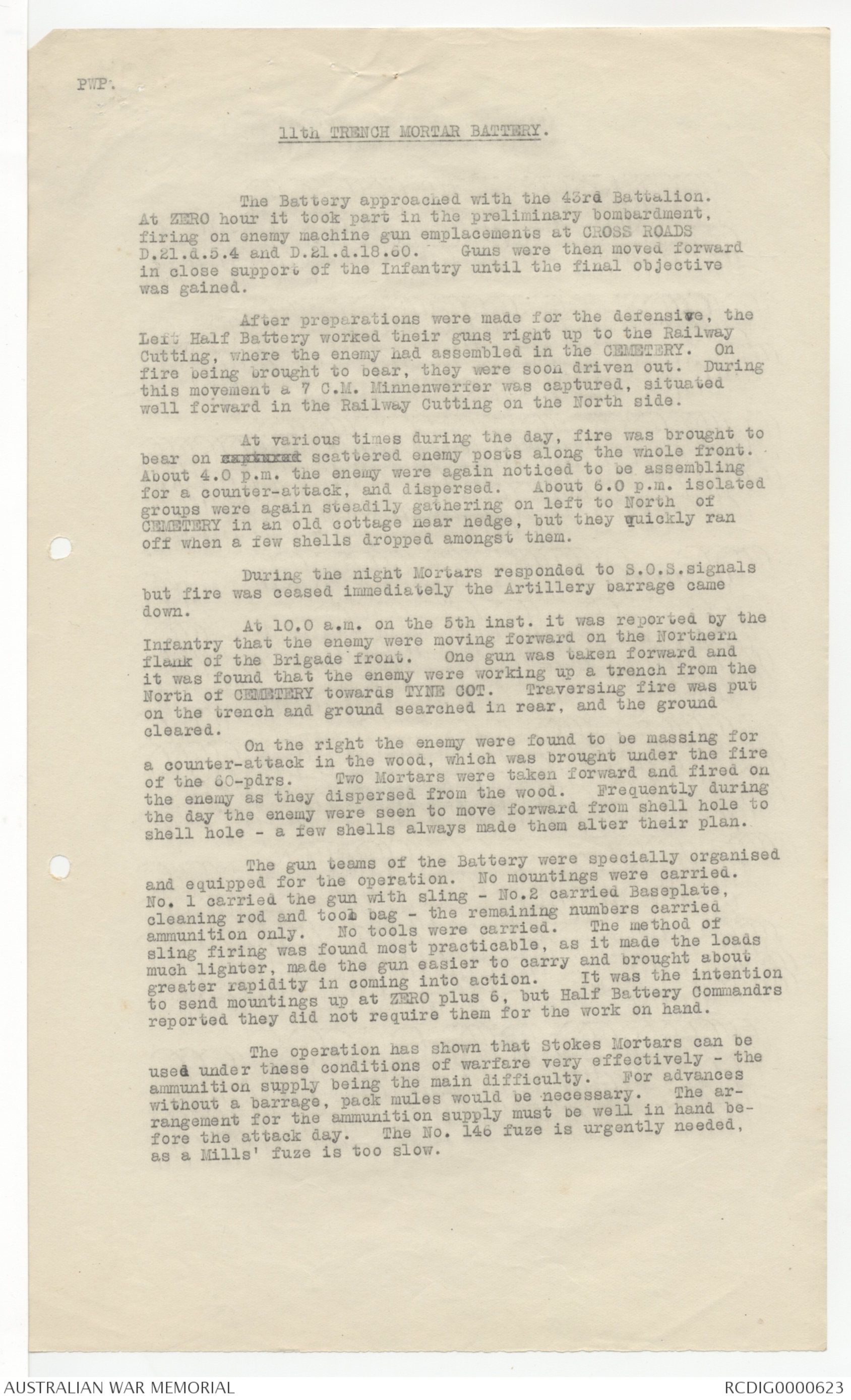
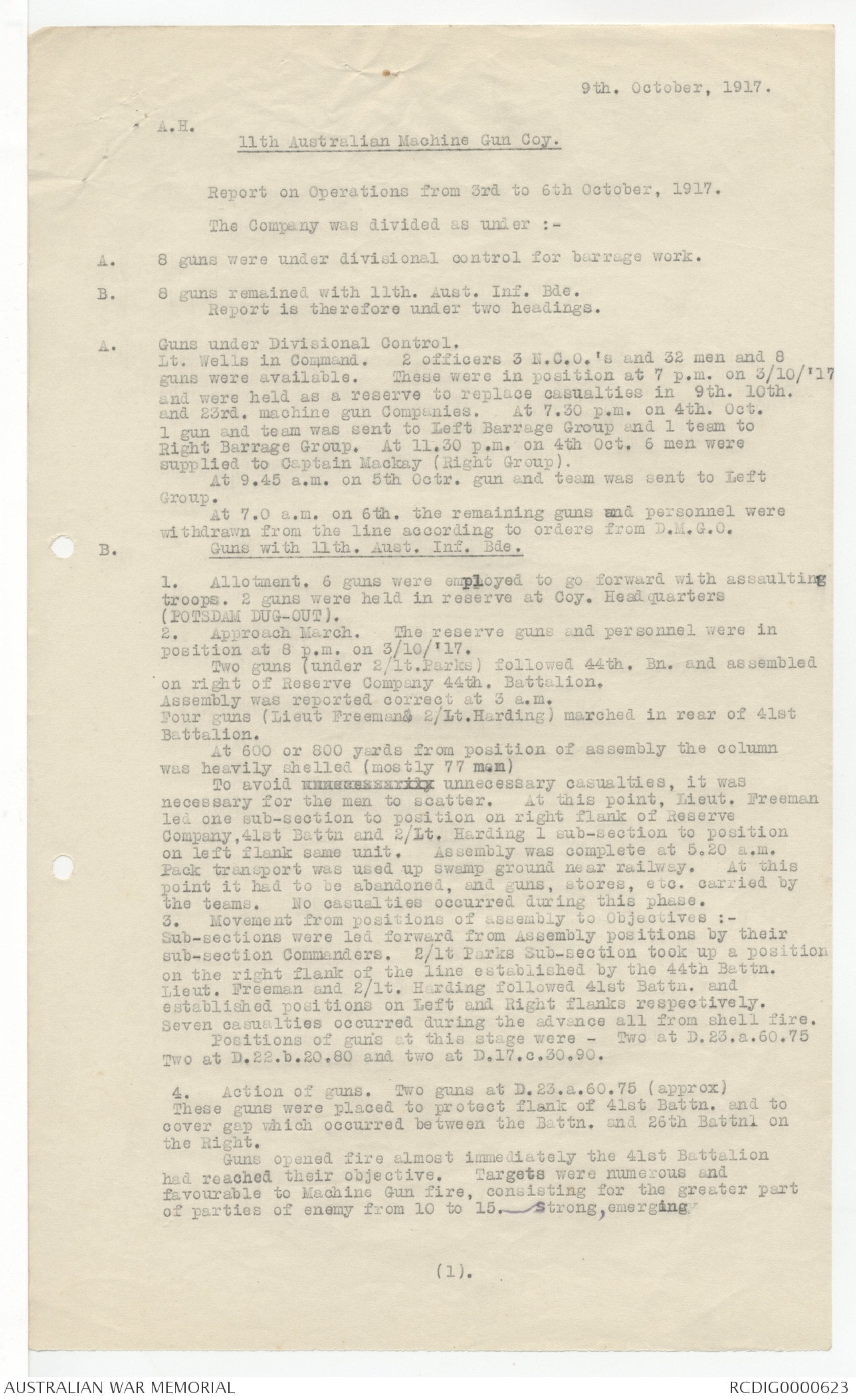
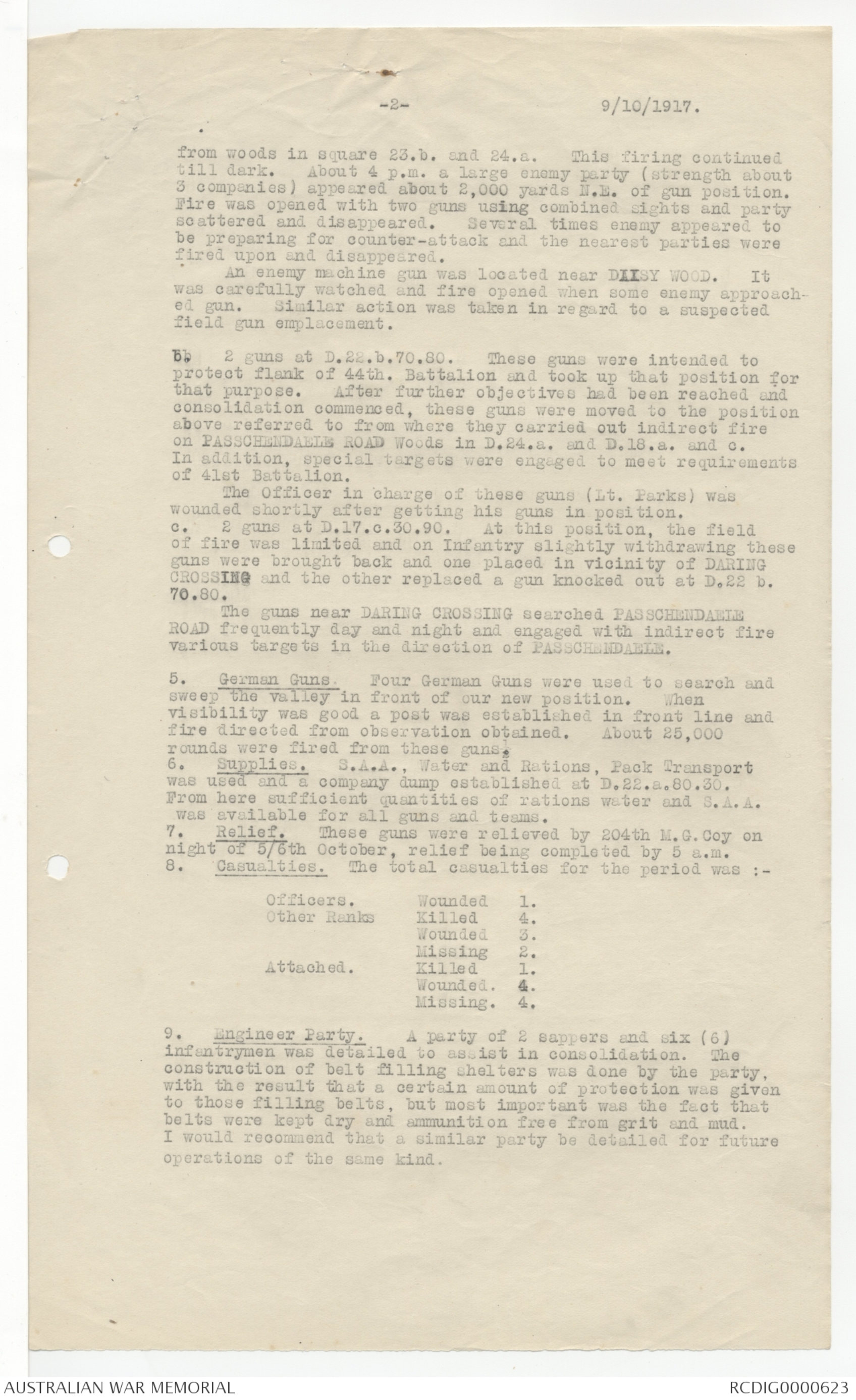
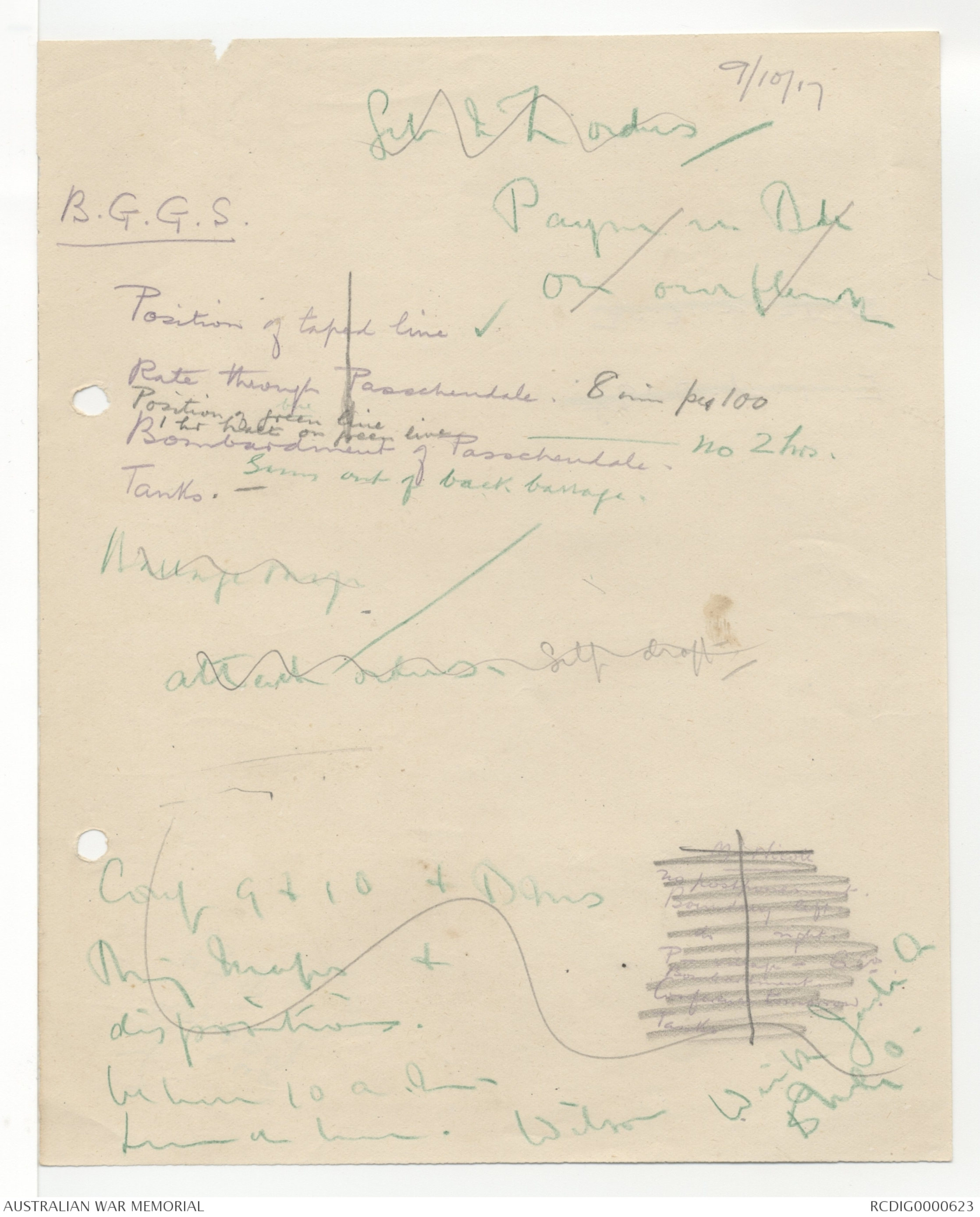
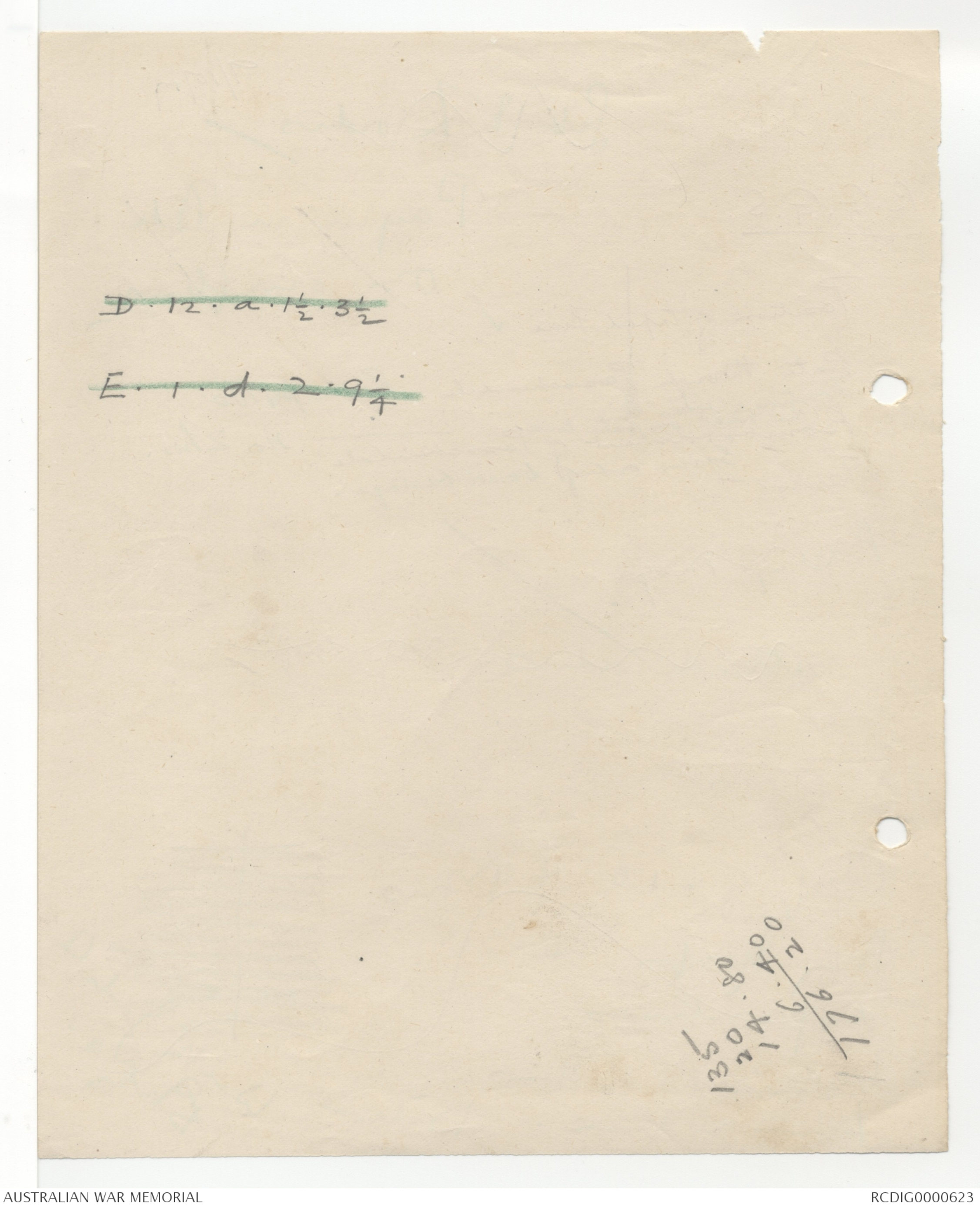
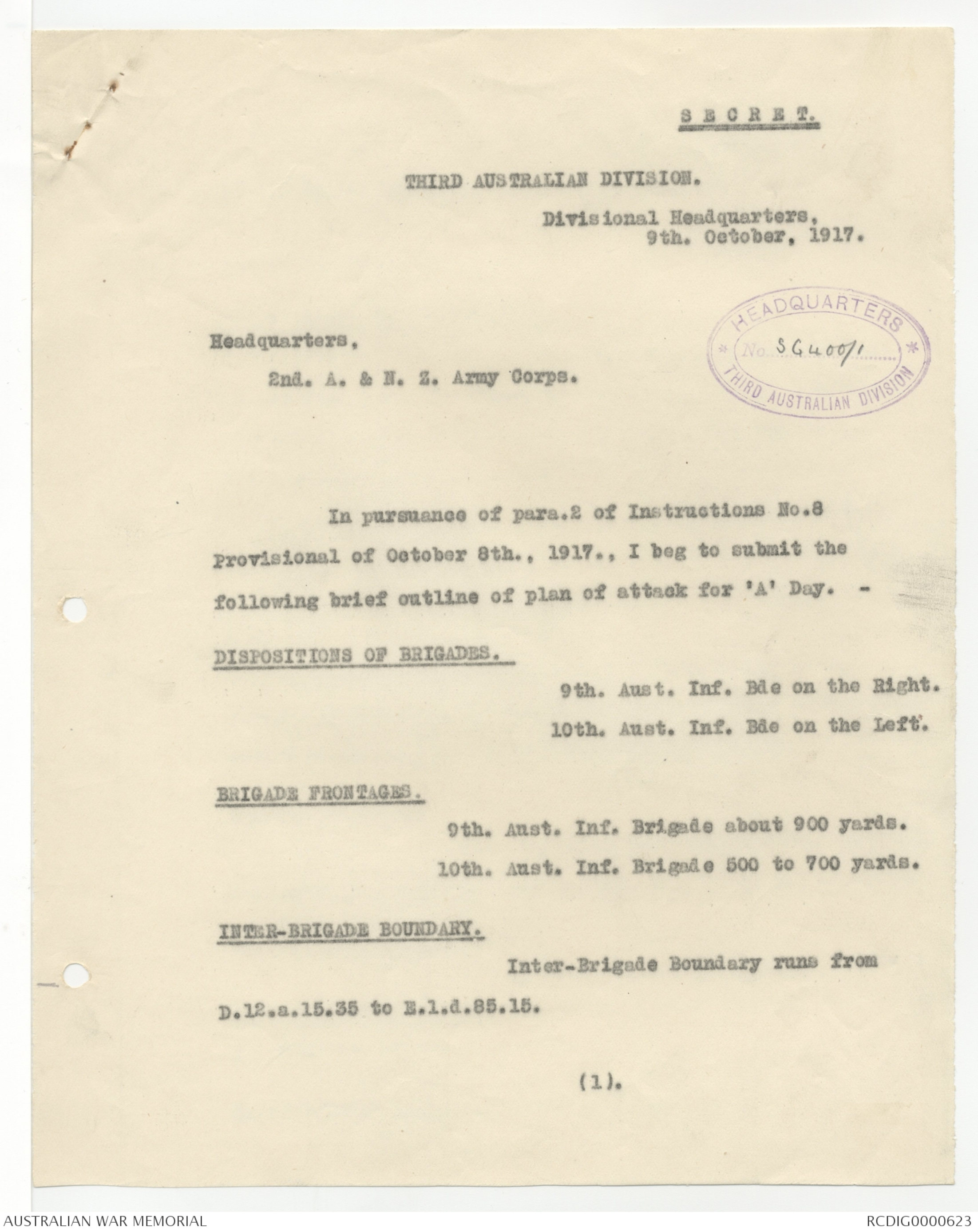
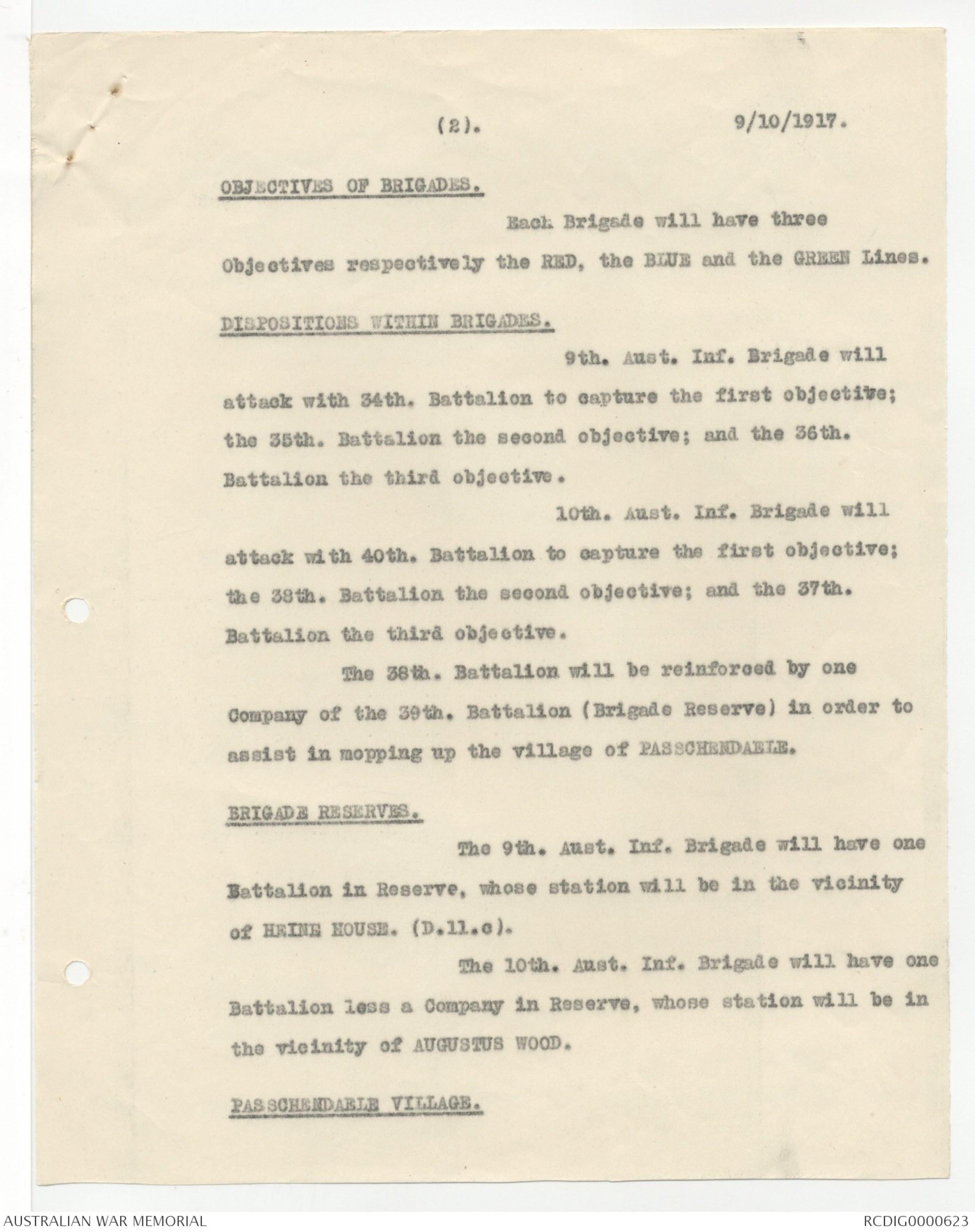
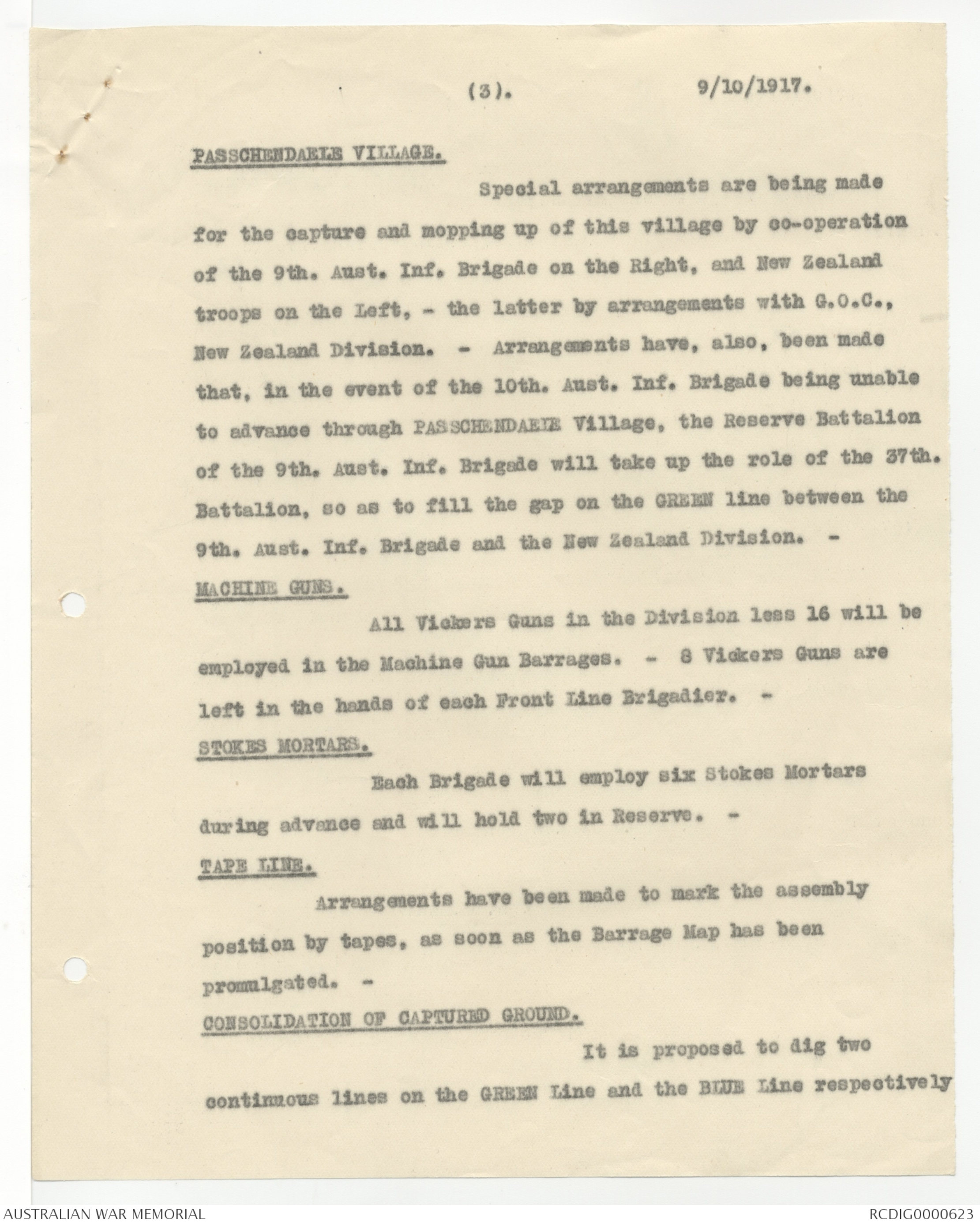
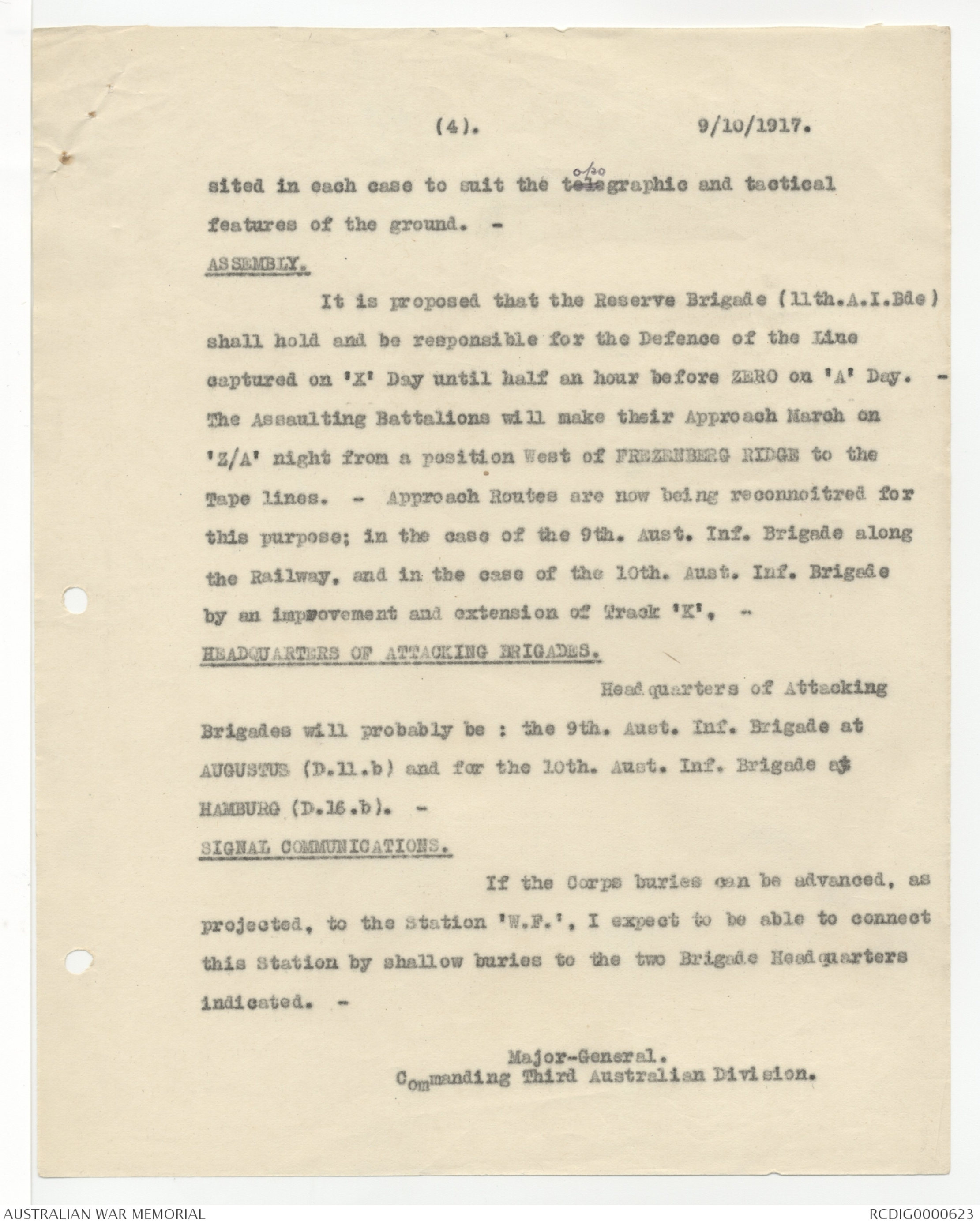
43rd. BATTALION (Continued). (2)
Estimated enemy losses -
Killed and wounded ... ... 800
Prisoners ... ... ... 400
Trophies captured -
6 machine guns
1 Telephone
1 Listening set
2 Tripod Trench Periscopes.
PWP.,
44th BATTALION. 9-10-1917
At 10.0 p.m. this Battalion moved off in a single file
from resting place near YPRES on approach march. We moved
by "F" track to place of assembly on HILL 40 just across
ZONNEBEKE Creek. We had one long halt of about ½ hour, in
addition to several short halts. A few enemy shells fell near
the track during the march, and two casualties were sustained.
We reported the Battalion moved up O.K. at place of
assembly at 2.0 a.m. on 4th instant. The men rested in shell
holes until ZERO hour. At 5.15 a.m. the enemy shelled the
Assembly area with "Whizz-bangs", 4.2 and 5.9 Shrapnel and H.E.
About 34 casualties occurred between 5.15 a.m. and 6.0 a.m.
ZERO hour.
At 6.0 a.m. our Attack Barrage came down on the enemy
lines and everybody hopped off without hesitation. During the
first 10 minutes or so, the three Battalions were rather mixed
up - after this the men began to sort themselves out & followed
their Platoon Officers in the general direction. During the
12 minutes halt in the barrage, Companys got into order and
prisoners began to give themselves up. Up to this time our
bayonets were frequently used.
During the next part of the attack, ALMA & ORCHARD
were passed and left to the 42nd to mop up; then we began to
cross the railway, our portion of which was mopped up by our
"mopping-up" platoons. This yielded a fair number of prisoners
- one concrete dugout on the right of the railway produced
about 30 prisoners and some machine guns.
This was roughly the line of the 42nd. objective.
Here we had a 47 minute halt in the barrage, in which to reorganise
the Companys. Reorganisation was carried out so
well that when the time came to go forward, every section and
platoon was in its appointed place.
During the 47 minute halt our barrage searched forward. This was taken by our troops on the right and left
as the move forward of the barrage and they followed it.
Runners were sent over by O.C. "B" Coy. to remind them of
what was happening with the barrage. The troops then began
to dribble back in slow time and reorganise ready for the next
advance. The barrage then came back and at the end of the 47
minutes, the barrage and troops began to move forward again.
We reached our objective, mopping up dugouts on the
DARING CROSSING Road on the way, and began to dig in. The
41st. then went through us towards their objective.
During the day the S.O.S. signal was put up in front
and on our flanks several times. Our S.O.S. barrage rapidly
came down and prevented any counter-attack coming through. An
Officer of the 41st Battalion sent a message through us to his
Battalion H.Q. asking for reinforcements and ammunition. I
sent up a platoon but it was sent back to me, saying they were
not required. I sent up what ammunition I could spare for
their Lewis Guns, as requested.
A Pioneer Officer and some Pioneers came up and proceeded
to dig a C.T. from the railway line near DARING CROSSING,
through our "B" Coy's sector towards the 41st Battalion. This
was not quite completed by dark when they returned to their
Battalion. By dark our trenches were almost completed; there
was a continuous trench 5 feet deep the Battalion sector; in
places
44th BATTALION (Continued). (2)
places overhead shelter had been put in, slits cut to shell holes
in rear for Platoon Dumps and Latrines. These trenches were improved
next day and a few small dugouts put in. The material for
this purpose was taken from houses and dugouts broken up by our own
shell fire.
On reaching our objective, 2 Lewis Gun posts were established
per Coy. 70 yards in front of our line. At
At 5.15 a.m. on morning of 5th our Practice Barrage came
down and searched forward. The retaliation to this came down well
behind our line. At 10.0 a.m. four wounded Boches and 1 unwounded
Boche, who had recovered from shock, were sent back under escort -
5 captured enemy machine guns were also sent back.
At 11.0 a.m. on the 5th. a Carrying Party brought up
water. At 12 noon, hot stew and dry rations came to Coy. H.Q.
These were distributed to the Battalion during the afternoon.
At 5.0 p.m. 4 guides per Coy. were sent down to guide
the relieving Coys. to our trenches. At 1.15 a.m. on the 6th
instant the relief arrived and took over. The relief was complete
and our Coys. had moved out by 4.0 a.m.
Total casualties for the Battalion were - 31 killed,
148 wounded, 8 missing. Casualties during the march out - 1
killed, 2 wounded.
In my opinion the enemy did not know where our line was,
because practically no enemy shells fell between DARING CROSSING
Road and our L.G.posts.
After being relieved the men went to the ASYLUM at YPRES,
where they had a hot meal and a rest before proceeding to this camp.
At 10.15 a.m. on the 4th. a 7.7 shell landed in Battalion
H.Q.'s dugout, wounding the C.O. and Adjt. who were evacuated.
I then took over command
PWP.
11th TRENCH MORTAR BATTERY.
The Battery approached with the 43rd Battalion.
At ZERO hour it took part in the preliminary bombardment,
firing on enemy machine gun emplacements at CROSS ROADS
D.21.d.5.4 and D.21.d.18.60. Guns were then moved forward
in close support of the Infantry until the final objective
was gained.
After preparations were made for the defensive, the
Left Half Battery worked their guns right up to the Railway
Cutting, where the enemy had assembled in the CEMETERY. On
fire being brought to bear, they were soon driven out. During
this movement a 7 C.M. Minnenwerfer was captured, situated
well forward in the Railway Cutting on the North side.
At various times during the day, fire was brought to
bear on captured scattered enemy posts along the whole front.
About 4.0 p.m. the enemy were again noticed to be assembling
for a counter-attack, and dispersed. About
6.0 p.m. isolated
groups were again steadily gathering on left to North of
CEMETERY in an old cottage near hedge, but they quickly ran
off when a few shells dropped amongst them.
During the night Mortars responded to S.O.S.signals
but fire was ceased immediately the Artillery barrage came
down.
At 10.0 a.m. on the 5th inst. it was reported by the
Infantry that the enemy were moving forward on the Northern
flank of the Brigade front. One gun was taken forward and
it was found that the enemy were working up a trench from the
North of CEMETERY towards TYNE COT. Traversing fire was put
on the trench and ground searched in rear, and the ground
cleared.
On the right the enemy were found to be massing for
a counter-attack in the wood, which was brought under the fire
of the 60-pdrs. Two Mortars were taken forward and fired on
the enemy as they dispersed from the wood. Frequently during
the day the enemy were seen to move forward from shell hole to
shell hole - a few shells always made them alter their plan.
The gun teams of the Battery were specially organised
and equipped for the operation. No mountings were carried.
No. 1 carried the gun with sling - No.2 carried Baseplate,
cleaning rod and tool bag - the remaining numbers carried
ammunition only. No tools were carried. The method of
sling firing was found most practicable, as it made the loads
much lighter, made the gun easier to carry and brought about
greater rapidity in coming into action. It was the intention
to send mountings up at ZERO plus 6, but Half Battery Commandrs
reported they did not require them for the work on hand.
The operation has shown that Stokes Mortars can be
used under these conditions of warfare very effectively - the
ammunition supply being the main difficulty. For advances
without a barrage, pack mules would be necessary. The arrangement
for the ammunition supply must be well in hand before
the attack day. The No. 146 fuze is urgently needed,
as a Mills' fuze is too slow.
9th. October, 1917.
A.H.
11th Australian Machine Gun Coy.
Report on Operations from 3rd to 6th October, 1917.
The Company was divided as under :-
A. 8 guns were under divisional control for barrage work
B. 8 guns remained with 11th. Aust. Inf. Bde.
Report is therefore under two headings.
A. Guns under Divisional Control.
Lt. Wells in Command. 2 officers 3 N.C.O.'s and 32 men and 8
guns were available. These were in position at
7 p.m. on 3/10/'17
and were held as a reserve to replace casualties in 9th. 10th.
and 23rd. machine gun Companies. At
7.30 p.m. on 4th. Oct.
1 gun and team was sent to Left Barrage Group and 1 team to
Right Barrage Group. At 11.30 p.m. on 4th Oct. 6 men were
supplied to Captain Mackay (Right Group).
At 9.45 a.m. on 5th Octr. gun and team was sent
to Left Group.
At 7.0 a.m. on 6th the remaining guns and personnel were
withdrawn from the line according to orders from D.M.G.O.
B. Guns with 11th. Aust. Inf. Bde.
1.Allotment. 6 guns were employed to go
forward with assaulting
troops. 2 guns were held in reserve at Coy. Headquarters
(POTSDAM DUG-OUT).
2. Approach March. The reserve guns and personnel were in
position at 8 p.m. on 3/10/'17.
Two guns (under 2/lt.Parks) followed 44th. Bn. and assembled
on right of Reserve Company 44th. Battalion.
Assembly was reported correct at 3 a.m.
Four guns (Lieut Freeman & 2/Lt. Harding) march in rear of 41st
Battalion.
At 600 or 800 yards from position of assembly the column
was heavily shelled (mostly 77 m.m)
To avoid unnecessarily unnecessary casualties, it was
necessary for the men to scatter. At this point, Lieut. Freeman
led one sub-section to position on right flank of Reserve
Company, 41st Battn and 2/Lt. Harding
1 sub-section to position
on left flank same unit. Assembly was complete at 5.20 a.m.
Pack transport was used up swamp ground near railway. At this
point it had to be abandoned, and guns, stores, etc. carried by
the teams. No casualties occurred during this phase.
3. Movement from positions of assembly to Objectives :-
Sub-sections were led forward from Assembly positions by their
sub-section Commanders. 2/lt. Parks
Sub-section took up a position
on the right flank of the line established by the 44th Battn.
Lieut. Freeman and 2/lt. Harding followed 41st Battn. and
established positions on Left and Right flanks respectively.
Seven casualties occurred during the advance all from shell fire.
Positions of guns at this stage were - Two at
D. 23.a.60.75
Two at D.22.b.20.80 and two at D.17.c.30.90.
4. Action of guns. Two guns at D.23.a.60.75 (approx)
These guns were placed to protect flank of 41st Battn. and to
cover gap which occurred between the Batt,. and 26 Battn. on
the Right.
Guns opened fire almost immediately the 41st Battalion
had reached their objective. Targets were numerous and
favourable to Machine Gun fire, consisting for the greater part
of parties of enemy from 10 to 15 strong, emerging
(1).
-2-
9/10/1917.
from woods in square 23.b. and 24a. This
firing continued
till dark. About 4 p.m. a large enemy party (strength about
3 companies) appeared about 2,000 yards N.E. of gun position.
Fire was opened with two guns using combined sights and party
scattered and disappeared. Several times enemy appeared to
be preparing for counter-attack and the nearest parties were
fired upon and disappeared.
An enemy machine gun was located near DAISY WOOD. It
was carefully watched and fire opened when some enemy approached
gun. Similar action was taken in regard to a suspected
field gun emplacement.
b. 2 guns at D.22.b.70.80. These guns were intended to
protect flank of 44th. Battalion and took up that position for
that purpose. After further objectives had been reached and
consolidation commenced, these guns were moved to the position
above referred to from where they carried out indirect fire
on PASSCHENDAELE ROAD Woods in D.24.a. and D.18.a. and c.
In addition, special targets were engaged to meet requirements
of 41st Battalion.
The Officer in charge of these guns (Lt. Parks) was
wounded shortly after getting his guns in position.
c. 2 guns at D.17.c.30.90. At this position, the field
of fire was limited and on Infantry slightly withdrawing these
guns were brought back and one placed in vicinity of DARING
CROSSING and the other replaced a gun knocked out at
D.22 b.70.80
The guns near DARING CROSSING searched PASSCHENDAELE
ROAD frequently day and night and engaged with indirect fire
various targets in the direction of PASSCHENDAELE.
5. German Guns. Four German Guns were used to search and
sweep the valley in front of our new position. When
visibility was good a post was established in front line and
fire directed from observation obtained. About
25,000 rounds were fired from these guns.
6. Supplies. S.A.A., Water and Rations, Pack Transport
was used and a company dump established at D.22.a.80.30.
From here sufficient quantities of rations water and S.A.A.
was available for all guns and teams.
7. Relief. These guns were relieved by 204th M.G. Coy on
night of 5/6th October, relief being completed by 5 a.m.
8. Casualties. The total casualties for the period was :-
Officers. Wounded 1.
Other Ranks Killed 4.
Wounded 3.
Missing 2.
Attached. Killed 1.
Wounded. 4.
Missing. 4.
9. Engineer Party. A party of 2 sappers and six (6)
infantrymen was detailed to assist in consolidation. The
construction of belt filling shelters was done by the party,
with the result that a certain amount of protection was given
to those filling belts, but most important was the fact that
belts were kept dry and ammunition free from grit and mud.
I would recommend that a similar party be detailed for future
operations of the same kind.
9/10/17Get [[?]] ordersPayne in Bdeon our flank
B.G.G.S.
Position of taped line√
Rate through Passchendale. 8 min per 100
Position of green line
1 hr halt on green line ——— (*no 2 hrs*)
Bombardment of Passchendale.
(*Guns out of back barrage.*)
Tanks. -
[[Manage?]] maps.Attach orders - Self draftCopy 9 & 10 DvnsBring maps &dispositions.
illegible crossed out text]]
D.12.a.1½.3½
E.1.d.2.9¼
(*135
20
14.80
6.40
———
176.20*)
S E C R E T.
THIRD AUSTRALIAN DIVISION.
Divisional Headquarters,
9th. October, 1917
HEADQUARTERS
No SG400/1
THIRD AUSTRALIAN DIVISION
Headquarters,
2nd. A. & N. Z. Army Corps.
In pursuance of para.2 of Instructions No. 8
Provisional of October 8th.,1917., I beg to submit the
following brief outline of plan of attack for 'A' Day. -
DISPOSITION OF BRIGADES.
9th. Aust. Inf. Bde on the Right.
10th. Aust Inf. Bde on the Left.
BRIGADE FRONTAGES.
9th. Aust. Inf. Brigade about 900 yards.
10th. Aust. Inf. Brigade 500 to 700 yards.
INTER-BRIGADE BOUNDARY.
Inter-Brigade Boundary runs from
D.12.a.15.35 to E.1.d.85.15.
(1).
-2-
9/10/1917.
OBJECTIVES OF BRIGADES.
Each Brigade will have three
Objectives respectively the RED, the BLUE and the GREEN Lines.
DISPOSITIONS WITHIN BRIGADES.
9th. Aust. Inf. Brigade will
attack with 34th. Battalion to capture the first objective;
the 35th. Battalion the second objective; and the 36th.
Battalion the third objective.
10th. Aust. Inf. Brigade will
attack with 40th. Battalion to capture first objective;
the 38th. Battalion the second objective; and the 37th.
Battalion the third objective,
The 38th. Battalion will be reinforced by one
Company of the 39th. Battalion (Brigade Reserve) in order to
assist in mopping up the village of PASSCHENDAELE.
BRIGADE RESERVES.
The 9th. Aust. Inf. Brigade will have one
Battalion in Reserve, whose station will be in the vicinity
of HEINE HOUSE. (D.11.e).
The 10th. Aust. Inf. Brigade will have one
Battalion less a Company in Reserve, whose station will be in
the vicinity of AUGUSTUS WOOD.
PASSCHENDAELE VILLAGE.
(3).
9/10/1917.
PASSCHENDAELE VILLAGE.
Special arrangements are being made
for the capture and mopping up of this village by co-operation
of the 9th. Aust. Inf. Brigade on the Right, and New Zealand
troops on the Left, - the latter by arrangements with G.O.C.,
New Zealand Division. - Arrangements have, also, been made
that, in the event of the 10th. Aust. Inf. Brigade being unable
to advance through PASSCHENDAELE Village, the Reserve Battalion
of the 9th. Aust. Inf. Brigade will take up the role of the 37th.
Battalion, so as to fill the gap on the GREEN line between the
9th. Aust. Inf. Brigade and the New Zealand Division. -
MACHINE GUNS.
All Vickers Guns in the Division less 16 will be
employed in the Machine Gun Barrages. - 8 Vickers Guns are
left in the hands of each Front Line Brigadier. -
STOKES MORTARS.
Each Brigade will employ six Stokes Mortars
during advance and will hold two in Reserve. -
TAPE LINE.
Arrangements have been made to mark the assembly
position by tapes, as soon as the Barrage Map has been
promulgated. -
CONSOLIDATION OF CAPTURED GROUND.
It is proposed to dig two
continuous lines on the GREEN Line and the BLUE Line respectively
(4).
9/10/1917.
sited in each case to suit the topographic and tactical
features of the ground. -
ASSEMBLY.
It is proposed that the Reserve Brigade (11th.A.I.Bde)
shall hold and be responsible for the Defence of the Line
captured on 'X' Day until half an hour before ZERO on 'A' Day. -
The Assaulting Battalions will make their Approach March on
'Z/A' night from a position West of FREZENBERG RIDGE to the
Tape lines. - Approach Routes are now being reconnoitred for
this purpose; in the case of the 9th. Aust. Inf. Brigade along
the Railway, and in the case of the 10th. Aust. Inf. Brigade
by an improvement and extension of Track 'K'. -
HEADQUARTERS OF ATTACKING BRIGADES.
Headquarters of Attacking
Brigades will probably be : the 9th. Aust. Inf. Brigade at
AUGUSTUS (D.11.b.) and for the 10th. Aust. Inf. Brigade at
HAMBURG (D.16.b.). -
SIGNAL COMMUNICATIONS.
If the Corps buries can be advanced, as
projected, to the Station 'W.F.', I expect to be able to connect
this Station by shallow buries to the two Brigade Headquarters
indicated. -
Major-General.
Commanding Third Australian Division.
 Sandy Mudie
Sandy MudieThis transcription item is now locked to you for editing. To release the lock either Save your changes or Cancel.
This lock will be automatically released after 60 minutes of inactivity.